Tag Archive for: FLT3 Inhibitors
FLT3 Inhibitors for AML Update
Introduction
Mutations in the FLT3 (fms-like tyrosine kinase 3) gene are the most common mutations seen in Acute Myeloid Leukemia (AML) patients. FLT3 mutations are seen in about 30% of AML patients. There are 2 different FLT3 mutations, FLT3-ITD (internal tandem duplication) mutation and tyrosine kinase domain mutations (TKD) mutation. Here I report some newer results of treatments with FLT3 inhibitors, that I have come across in the last several months.
There are quite a few drugs that target the FLT3 gene, including:
First generation drugs:
- Sorafenib (Nexavar)
- Midostaurin (Rydapt)
- Lestaurtinib clinical development of lestaurtinib has been discontinued as it did not provide significant clinical benefit.
Second generation drugs, which tend to have fewer and less severe side effects and are more effective include:
- Gilteritinib (Xospata)
- Quizartinib (Vanflyta) – Only for ITD mutations.
- Crenolanib – Not FDA approved.
FLT3 inhibitors are effective treatments for AML with a FLT3 mutation. However, there are still a number of open questions. How should FLT3 inhibitors be used, with induction chemo, with consolidation chemo and/or for maintenance after a stem cell transplant (SCT) or chemo? Can they be used as a single agent for treating patients who are not good candidates for chemotherapy? Do they work well with newer treatments, specifically with azacitidine and ventoclax regimens? There have not been a lot of comparison between the different drugs. Finally, there is the question of why all these drugs have names that are barely pronounceable!
Gilterinib
There is a new study looking at the use of gilterinib as maintenance after SCT. This was a multi-national randomized study, comparing maintenance with gIlterinib against placebo. The result was overall the patients who received gilterinib had better relapse-free survival (RFS) compared to patients who received placebo. However, this difference was not considered statically significant. However, the trial had a pre-specified secondary objective to look at the subgroup of patients who had measurable residual disease (MRD), that is they were MRD+.
About half of the patients were MRD+ either before SCT or after (or both). In this group, the RFS survival in the patients receiving gilterinib was significantly greater than the placebo group. Unfortunately, there were more side effects in the gilterinib group. It is likely that, because of this study, patients who are FLT3+ and undergoing a transplant will get gilterinib as maintenance if they are MRD+ and not if they are MRD-. The use of gilterinib or other FLT3 inhibitors as maintenance therapy will continue to be a subject of active research.
Quizartinib
I wrote a post on quizartiinb: Quizartinib in FLT3-ITD-Positive AML that was an overview of a trial of this drug along with induction and consolidation chemo and as maintenance after chemotherapy. In July, 2023, Quizartinib was approved for treatment of FLT3-ITD AML in the United States by the FDA.
Crenolanib
Crenolanib is a second-generation FLT3 agent that works for both FLT3-ITD and FLT3-TKD mutations. In Crenolanib and Intensive Chemotherapy for Adults With Newly Diagnosed FLT3-Mutated AML, crenolanib was given with “7+3:” induction and then with consolidation chemotherapy and as maintenance therapy after consolidation chemo and after a SCT. About 2/3 of patients were younger than 60, but patients as old as 75 were included. Although this was not a randomized trial and was fairly small (44 patients), it seemed that Crenolanib added to chemotherapy and as maintenance improved survival compared to midostaurin (the first drug approved for FLT3 AML) and quizartiinb (described above).
Sorafenib
While sorafenib is an FLT3 inhibitor, this first study is on its use in AML patients even if they did have a FLT3 mutation. Previous studies had shown sorafenib improved survival when given with standard “7+3” induction for AML. This study (Sorafenib Plus Cladribine, High-Dose Cytarabine, G-CSF, and Mitoxantrone for Untreated AML) looked at sorafenib with cladribine, high-dose cytarabine, granulocyte colony–stimulating factor, and mitoxantrone (CLAG-M). The first part of the study (Phase I) tried increasing doses of sorafenib and mitoxantrone. The Phase II part of the study used the recommended phase 2 dose (RP2D) to treat more patients. When compared with historical controls who received CLAG-M without sorafenib, the patients who received the RP2D had improved survival.
Finally, there is a report on the long term follow-up of a trial looking at using sorafenib as maintenance therapy after a transplant (Sorafenib Maintenance After Allogeneic HSCT in Patients With AML With FLT3 Internal Tandem Duplications). The use of sorafenib as maintenance reduced relapse which improved survival in patients with FLT3-ITD AML. The non-relapse mortality and the incidence of chronic Graft-Versus-Host Disease (GVHD) in those who had a transplant was similar in patients who received sorafenib and those who did not. This result was sustained long-term (with a median follow-up of about 5 years).
Conclusion
The best way to use FLT3 inhibitors in patients with FLT3 mutation is still an area of active research. Newer agents promise better results – fewer side effects and better survival.
Further Reading
FLT3 Tyrosine Kinase Inhibitors for the Treatment of Fit and Unfit Patients with FLT3-Mutated AML: A Systematic Review, Int J Mol Sci. 2021 Jun; 22(11): 5873.
Molecular Mechanisms of Resistance to FLT3 Inhibitors in Acute Myeloid Leukemia: Ongoing Challenges and Future Treatments, Cells 2020, 9(11), 2493.
Gilteritinib as Posttransplant Maintenance for AML With Internal Tandem Duplication Mutation of FLT3, Practice Update (registration required, free), March 26, 2024.
Gilteritinib as Post-Transplant Maintenance for Acute Myeloid Leukemia With Internal Tandem Duplication Mutation of FLT3, Medscape, June 21, 2023.
Gilteritinib as Post-Transplant Maintenance for Acute Myeloid Leukemia With Internal Tandem Duplication Mutation of FLT3, Journal of Cinical Oncology. March 12, 2024..
Quizartinib Approval Adds New Treatment Option for AML, Including in Older Patients , National Cancer Institute, Cancer Currents Blog , August 15, 2023.
Crenolanib and Intensive Chemotherapy for Adults With Newly Diagnosed FLT3-Mutated AML, Practice Update (registration required, free), March 4, 2024.
Crenolanib and Intensive Chemotherapy in Adults With Newly Diagnosed FLT3-Mutated AML (JCO article) Journal of Clinical Oncology February 07, 2024.
Sorafenib Plus Cladribine, High-Dose Cytarabine, G-CSF, and Mitoxantrone for Untreated AML Practice Update (registration required, free), July 25, 2023.
Phase 1/2 study of sorafenib added to cladribine, high-dose cytarabine, G-CSF, and mitoxantrone in untreated AML, Blood Adv (2023) 7 (17): 4950–4961.
Sorafenib Maintenance After Allogeneic HSCT in Patients With AML With FLT3 Internal Tandem Duplications, Practice Update (registration required, free), July 25, 2023.
Sorafenib maintenance after allogeneic haemopoietic stem-cell transplantation in patients with FLT3-ITD acute myeloid leukaemia: long-term follow-up of an open-label, multicentre, randomised, phase 3 trial, The Lancet, Volume 10, ISSUE 8, e600-e611, August 2023

AML Network Manager
Art Flatau lives in Austin, Texas with his wife Gretchen. They have 2 grown children. He was diagnosed with Acute Myeloid Leukemia (AML) in 1992 at the age of 31, while still in graduate school at the University of Texas. Gretchen and Art’s kids were 2 and 4 at the time. He received chemotherapy (both induction chemotherapy and then consolidation). After graduating with a Ph.D. in computer science in December 1992. He relapsed in early 1993 and then had a bone marrow transplant (BMT), his brother was a perfect match.
Advancements in AML Treatment | Tailoring Therapies to Individual Patients
Advancements in AML Treatment | Tailoring Therapies to Individual Patients from Patient Empowerment Network on Vimeo.
What are the latest AML treatment advancements? Expert Dr. Sara Taveras Alam from UTHealth Houston discusses how treatments have advanced over recent years with personalized therapies beyond a one-size-fits-all approach.
[ACT]IVATION Tip
“…patients to be really informed about all of the details of their AML and ask questions about the genetic drivers of their disease and whether or not there are medications that can target those drivers. Similarly, the decision to do a stem cell transplant or not will be driven by this, so it’s very important for the patient to be informed about all of the details of their AML, not just the fact that they have acute myeloid leukemia diagnosis.”
Download Resource Guide | Descargar guía de recursos
Related Resources:
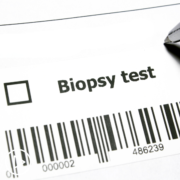
AML Diagnosis | Exploring Bone Marrow Biopsy and Alternatives |

|
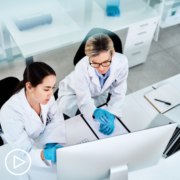
|
Transcript:
Lisa Hatfield:
Dr. Taveras, what are the latest advancements and treatment modalities for AML?
Dr. Sara Taveras Alam:
Well, over the last decade, there have been many new medications approved for the treatment of AML, and this has really allowed for the treatment of acute myeloid leukemia to be individualized rather than using a one-size-fits-all approach, so typically for us to decide the treatment that best suits the patient, we take into consideration patient characteristics and into consideration, their age and their fitness level, other medical problems that they may have, and we also take into consideration characteristics of the leukemia itself, so not all acute myeloid leukemia are the same, and we try to get as much information as we can about what is driving the acute myeloid leukemia to see how we can best attack it.
One of the medication groups that we have available to us over the last decade are FLT3 inhibitors, and that is a class of medication that directly targets FLT3 mutations that may be present in patients with AML, and if the patient does have a FLT3 mutation and they’re able to be started on this class of medication, they do a lot better than they would have done, say, 20 years ago without those medications being available. Similarly, we have medications that target IDH mutations, IDH1 or 2 that are options for our patients. We have less intensive chemotherapy that is more appropriate for older patients with comorbidities, perhaps maybe more tolerable than the traditional IV intensive chemotherapy.
So my activation tip for this question is for patients to be really informed about all of the details of their AML and ask questions about the genetic drivers of their disease and whether or not there are medications that can target those drivers. Similarly, the decision to do a stem cell transplant or not will be driven by this, so it’s very important for the patient to be informed about all of the details of their AML, not just the fact that they have acute myeloid leukemia diagnosis.
Share Your Feedback About [ACT]IVATED AML
AML Clinical Trials Critical to Treatment Breakthroughs and Improvements
AML Clinical Trials Critical to Treatment Breakthroughs and Improvements from Patient Empowerment Network on Vimeo.
Why are acute myeloid leukemia (AML) clinical trials so critical? Dr. Naval Daver from the University of Texas MD Anderson Cancer Center shares his perspective about clinical trials. Learn how clinical trials help both current and future AML patients.
[ACT]IVATION TIP from Dr. Daver: “Clinical trials are critical, both for the patients themselves to get access to what we call tomorrow’s medicine today as well as potentially to help move the entire field forward.”
Download Resource Guide en español
Related Resources:

|

What Promising AML Treatments Are Available for Newly Diagnosed Patients? |

|
Transcript:
Art:
Dr. Daver, what is the importance of clinical trial participation as it relates to breakthroughs in AML, and what advice do you have for AML patients considering a clinical trial?
Dr. Naval Daver: Clinical trials are critical for the progress that we have already seen an acute myeloid leukemia, the drugs that have been improved in the last six, seven years, including venetoclax (Venclexta), FLT3 inhibitors, midostaurin (Rydapt or Tauritmo), gilteritinib (Xospata), hopefully quizartinib other emerging targeted therapies…IDH1, IDH2 inhibitors, menin inhibitors, CD47 antibodies, we’ve learned about all of them and have got approvals and many of them through the ongoing clinical trials.
I think it’s very important for patients to realize that in most large academic centers, we will only participate in the clinical trial if we think it has the potential to improve the standard of care in the future. There’s very little incentive for academic investigators or clinical investigators, such as myself, we’re very, very busy to get involved in a trial if we don’t think that it has the potential to improve the outcome or change the nature of AML therapy in the future, so a lot of patients often ask me, Oh, I want the randomized or placebo arm. There is no real placebo alone in any AML study that I’m aware of, most of the studies will use standard of care, which is what you would’ve gotten wherever you were getting treatment at home, locally, community hospital versus a standard of care plus where the new drug will be added, whether it’s the FLT3 inhibitor, the CD47 antibody, the menin inhibitor
So there’s a good chance, 50 percent that you’re going to get standard of care plus that we think has the potential to improve the outcome, of course, you never know, that’s what you do, the trial, but we think based on the previous pre-clinical data to pass when the page to deliver this looks like it will improve the outcome for this molecular or site group versus standard of care, which is what you will have gotten.
So I think it’s important to realize that you will never get less on standard of care and any clinical trial, at least in the AML field, and at least in our experience that they understand.
Now, beyond that, there’s also a Phase I in two states, and those are the ones that we focus on quite a bit at MD Anderson, these are single arm studies, meaning everybody will get the investigational agent combo, so azacitidine (Onureg or Vidaza) and venetoclax (Venclexta), we were one of the first sites to work on and leave this study and all of our patients in 2015, 2016, we’re getting this regiment, it was not approved to much later in 2019, 2020, and for those three, four years, our patients, hundreds of patients were able to get that combination, which probably cured many, many more than would have been cured to the standard of care until, of course, I’ve got a pro four years later, but for an option, of course, you cannot wait four years, so I’m a huge believer in clinical trials, I think it’s really, really important, both for the patients themselves as well as for the field, for us to be able to move the entire AML field forward for the next decade, and I would very strongly consider looking at or discussing with your treating physician trial options, and then you can look at them on your own through clinicaltrials.gov, or other sites with leukema and lymphoma that give a lot of information on clinical trials.
So my activation tip related to this question is that I think clinical trials are critical, both for the patients themselves to get access to what we call tomorrow’s medicine today as well as potentially to help move the entire field forward, all of the clinical drug approvals in progress we have seen in AML in the last six, seven years have come through clinical trials that patients in the past have agreed to kindly participate and helped probably themselves by getting better medications and combinations, and definitely the field to move forward, so definitely a big proponent for clinical trials.
Share Your Feedback About [ACT]IVATED AML
The Importance of the FLT3 Mutation in AML
The Importance of the FLT3 Mutation In AML from Patient Empowerment Network on Vimeo.
What do acute myeloid leukemia (AML) patients need to know about FLT3 mutation? Dr. Naval Daver from the University of Texas MD Anderson Cancer Center discusses considerations about the mutation. Learn about the incidence of the FLT3 mutation, risk of relapse, and treatment options.
[ACT]IVATION TIP from Dr. Daver: “ it is very important to know the status of the FLT3 the mutation, both in diagnosis to see if one would benefit by the addition of the FLT3 inhibitor to the frontline induction chemo as well as in relapse because this would open up the option for FLT3 inhibitor targeted therapies, which would probably have the best chance of response and long-term outcomes.“
Download Resource Guide en español
Related Resources:
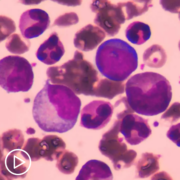
|

|
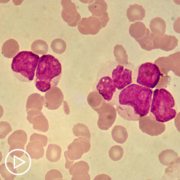
|
Transcript:
Art:
Dr. Daver, for AML with a FLT3 mutation, what have we learned, and what is currently being investigated?
Dr. Naval Daver:
AML with the FLT3 mutation is very important from both prognostic and from therapy perspective, prognostically, this is considered to be one of the high-risk mutations, it’s also one of the most frequent mutations in AML in, seen in about 30 to 35 percent of younger and about 15 to 20 percent of older patients with AML, and these patients often have very prolific disease, elevated white count leukocytosis. And without the addition of FLT3 inhibitors, there is a high risk of relapse and a short overall survival.
Over the last 15 years, a number of targeted therapies called the FLT3 inhibitors have emerged, these started with the first-generation FLT3 inhibitors drugs, such as lestaurtinib and sorafenib (Nexavar), now we have the second-generation FLT3 inhibitors, this includes drugs like gilteritinib (Xospata), quizartinib, and crenolanib which are more potent, specific, and better tolerated.
The first study that showed that the incorporation of FLT3 inhibitors improves outcome was a study called RATIFY Study, this is a frontline study looking at newly diagnosed FLT3 mutated younger patients where we added the FLT3 inhibitor midostaurin (Rydapt or Tauritmo), which is the first-generation FLT3 inhibitor to the standard induction chemo versus a placebo, added to standard induction chemo, induction chemo being standard of care to that time and this showed that in the addition of FLT3 inhibitor to induction chemo did improve remission rates and overall survival as compared to induction, and led to the approval of the FLT3 inhibitor midostaurin in the frontline setting.
Since then, two other FLT3 inhibitors, second-generation potent FLT3 inhibitors drugs called gilteritinib, and lestaurtinib have also been evaluated. Gilteritinib, in a relapsed setting where single-agent gilteritinib, has given 50 to 60 percent response rates and has been extremely well-tolerated and much better than any other salvage treatment in the FLT3 space that we have ever seen, and in the frontline setting quizartinib and second-generation inhibitor also very recently, just a few months ago, there was data showing the combination of his art with intensive chemotherapy improved survival as compared to intensive chemotherapy alone.
And so we think we are…they will be a third for the inhibitor to get approved, so there’s been a lot of progress overall in the three space, and there are other newer FLT3 inhibitors also in early clinical investigation that we think could eventually be as part or even better, the activation point related to this question is that, for the inhibitors have dramatically improved outcomes, both in the frontline setting when added to traditional backbone intensive chemotherapy as well as potentially lower intensity therapy, as well as in the relapsed refractory setting, and it is very important to know the status of the FLT3 the mutation, both in diagnosis to see if one would benefit by the addition of the FLT3 inhibitor to the frontline induction chemo as well as in relapse because this would open up the option for FLT3 inhibitor targeted therapies, which would probably have the best chance of response and long-term outcomes.
Share Your Feedback About [ACT]IVATED AML
What Promising AML Treatments Are Available for Newly Diagnosed Patients?
What Promising AML Treatments Are Available for Newly Diagnosed Patients? from Patient Empowerment Network on Vimeo.
What do newly diagnosed acute myeloid leukemia (AML) patients have for promising treatment options? Dr. Naval Daver from the University of Texas MD Anderson Cancer Center discusses progress in available treatments. Learn about therapies determined by key factors.
[ACT]IVATION TIP from Dr. Daver: “It’s very important to really consider all the available treatment options and if needed to seek consultation with an expert or academic center to get the most up-to-date treatments available for AML.“
Download Resource Guide en español
Related Resources:

|
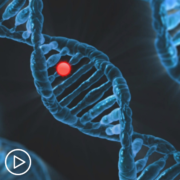
|
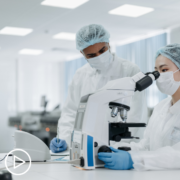
|
Transcript:
Art:
Dr. Daver, for newly diagnosed AML patients, what are the latest and most promising available therapies?
Dr. Daver:
For newly diagnosed AML at this time, the most promising agents include targeted therapies and BCL-2 inhibitor treatments, these are non-chemotherapeutic drugs, and we’ve seen great progress in the application of these as well as recent FDA approvals.
So one of these is an agent called venetoclax (Venclexta), which is a BCL-2 inhibitor and venetoclax in combination with hypomethylating agents such as azacitidine (Onureg or Vidaza) has shown a response to close to 75 percent.
And the nice thing is that this regimen can be given and patients who are older than 70, 75 years of age, and even those who are having comorbidities are not fit for traditional intensive chemotherapy with similar response rates, so this has been approved in the last couple of years for the frontline treatment of AML, and we’ve been using this combination of venetoclax and azacitidine quite frequently with high efficacy in this patient population, the other new agents that have shown breakthroughs in AML are the targeted therapies, these include FLT3 inhibitors that target the FLT3 mutation and these have shown good activity, but the single agents with gilteritinib (Xospata) being approved in the relapsed refractory setting as a single agent where gilteritinib showed a response rate of about 50 percent as a single oral targeted therapy in relapsed FLT3-mutated AML, which is actually better than the response rate with high-dose combination more where the response rate is only about 25 to 30 percent.
So, gilteritinib is now approved, and it’s now moving and being evaluated in frontline setting other FLT3 inhibitors like lestaurtinib (CEP-701), actually just recently completed frontline studies showing improved outcome when lestaurtinib added to intensive chemo versus just intensive chemo in FLT3 in AML. And we hope and think there’s a good chance lestaurtinib will be approved in the near future.
And also IDH inhibitors have been approved both in the relapsed setting, frontline setting, and now we even have a third group of targeted therapy is called the menin inhibitors, they target MLL rearrangement and NPM1 mutations, which are seen in about 15 percent to 20 percent of the AML, so there’s been a lot of progress.
All of this in the last seven years, six, seven years with multiple targeted therapies, with multiple inhibitor-based treatments, showing progress in AML and then also recently, the concept of maintenance therapy, this is something we used for the last couple of decades in a acute lymphoblastic leukemia and multiple myeloma and in lymphoma.
But we had not had clear data in AML, but the recent study using oral formulation of a azacitidine in CC486 has shown the maintenance in patients who complete an induction consolidation and could not go to allogeneic stem cell transplant for one reason or the other was important and improve both overall survival and relapse-free survival, and so this is the first time now we have an FDA-approved and standard use of maintenance therapy after the traditional induction consolidation, so even changing the general paradigm of AML therapy.
So a lot has changed in the last seven to eight years in the treatment of acute myeloid leukemia, and this is very exciting.
And the activation tip related, this question is that there are multiple new targeted and low intensity therapeutic options available for patients with acute myeloid leukemia, and in our institution, in my opinion, even older patients are eligible for some form of therapy or the other…very few patients, if any, today, are being sent to hospitals or palliative care without treatment.
So it’s very important to really consider all the available treatment options and if needed to seek consultation with an expert or academic center to get the most up-to-date treatments available for AML.
Share Your Feedback About [ACT]IVATED AML
What Is FLT3-Mutated Acute Myeloid Leukemia?
What Is FLT3-Mutated Acute Myeloid Leukemia? from Patient Empowerment Network on Vimeo.
Some acute myeloid leukemia (AML) patients may have an FLT3 mutation. Dr. Catherine Lai from Penn Medicine shares insight about the two types of FLT3 mutation, treatment options for FLT3-mutated AML, and progress in research
[ACT]IVATION TIP from Dr. Lai: “Ask your oncologist, if your FLT3 mutation testing was done, ask which type of mutation they have, if it’s the ITD or TKD, if they are FLT3-positive and what the drug options are available for them.”
Download Resource Guide en español
Related Resources:

|

|
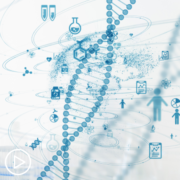
BIPOC Patients Living with AML | Mortality Rate and Favorable Genetics |
Transcript:
Art:
Dr. Lai, what is FLT3 mutated AML and what treatment options do patients with FLT3 AML have?
Dr. Catherine Lai:
Yeah, so FLT3, FLT3 mutations occur in about 25 percent to 30 percent of patients. There are two different types of FLT3 mutations. There’s a FLT3, the ITD mutation and the FLT3, the TKD mutation. They just are there, different parts of the mutation on different parts of the cell, and so how I think about that is, if you think of a leukemia cell and each leukemias has a different color-coded flag, and so the FLT3 mutation I think of is just having a specific color coding, and while a FLT3 mutation in general does predict for a worse prognosis for patients, we do have targeted treatments. In a newly diagnosed setting, we have midostaurin (Rydapt), which is added to intensive chemotherapy for those fit enough to tolerate it.
And in the relapsed refractory setting, we have a medication called gilteritinib (Xospata), which is given as a single agent, so a chemo pill, and that was compared to all types of chemotherapy, both intensive and low intensive chemotherapy, and that pill alone and the refractory and relapsed setting was better than either of the chemotherapies alone, so we’ve made a lot of progress for the FLT3-mutated patients to the majority of those patients end up going to transplant if possible, and so there are studies that are looking at FLT3 inhibitors in the post-transplant setting to also help improve long-term survival and overall survival. So the activation tip from that standpoint, that is to ask your oncologist, if your FLT3 mutation testing was done, ask which type of mutation they have, if it’s the ITD or TKD, if they are FLT3-positive and what the drug options are available for them.
Share Your Feedback About [ACT]IVATED AML
[ACT]IVATED AML Resource Guide
Which Tests Do You Need Before Deciding on an AML Treatment Path?
Which Tests Do You Need Before Deciding on an AML Treatment Path? from Patient Empowerment Network on Vimeo.
Why is it important to ask about biomarker testing for your AML? Find out how test results could reveal more about your AML and may help determine the most effective treatment approach for your individual disease.
Related Resources:

|

|

|
Transcript:
Why do you need biomarker testing before deciding on a treatment plan for your acute myeloid leukemia—also known as AML?
The results may predict how your AML will behave and could indicate that one type of treatment may be more effective than another.
Biomarker testing—also referred to as risk stratification, genetic testing, or molecular testing—identifies specific gene mutations, proteins, chromosomal abnormalities and/or other molecular changes that are unique to your AML.
The results of these tests are used to determine if you have low-risk or high-risk AML to help guide prognosis and to evaluate the goals of treatment.
There are certain biomarkers—such as the FLT3, IDH1 and IDH2 mutations—that could indicate that your AML may respond well to a targeted therapy. There are several FDA-approved targeted therapies—known as inhibitor therapies—which treat patients with these mutations.
Additionally, the identification of other biomarkers—such as TP53, NPM1, or CEBPA mutations, to name a few—may aid in assessing your prognosis, determining a treatment course, or may identify if an allogeneic stem cell transplant may be appropriate. Results of these tests may also suggest that a clinical trial is your best treatment option.
So, how can you Insist on the best care for YOUR AML?
• First, always bring a friend or a loved one to your appointments to help you process information and to take notes.
• Ask your doctor if you have had, or will receive, biomarker testing and how the results may impact your care and treatment plan. Be sure to ask for paper or electronic copies of your important test results.
• Finally, always speak up and ask questions. It’s important that you understand all of the information that you want to know about your AML to help make the best treatment decisions for you. You are your own best advocate, and treating AML is a team approach.
To learn more about your AML and to access tools for self-advocacy, visit powerfulpatients.org/AML.
AML Targeted Therapies, What’s Available and How Do They Work?
AML Targeted Therapies, What’s Available and How Do They Work? from Patient Empowerment Network on Vimeo.
There are several targeted therapies approved for the treatment of acute myeloid leukemia (AML). Expert Dr. Ellen Ritchie provides insight about recent approvals, how these therapies work, and shares details about newer therapies currently being studied for the treatment of AML.
Dr. Ellen K. Ritchie is assistant professor of medicine and a member of the Leukemia Program at the Weill Cornell Medical College of Cornell University and the New York Presbyterian Hospital. More about Dr. Ritchie, here.
Related Resources:

|

|
Transcript:
Katherine:
You touched upon this earlier, but what targeted therapies or treatments are available for AML patients?
Dr. Ritchie:
So, there have been many recent FDA approvals of drugs that are targeted. One, is the FLT3 inhibitors. And the two that are available are Midostaurin, which is most commonly – was the first drug that was really added to intensive chemotherapy.
And clinical trials show that in those FLT3-positive population that patients had an overall better outcome if midostaurin (Rydapt) were added to intensive chemotherapy. There’s also a drug called gilteritinib (Xospata), and this drug is also a FLT3 inhibitor that was tested in patients who had refractory leukemia. They could either get real chemotherapy regimen or they could get gilteritinib. And it turns out in the FLT3-positive patients, the gilteritinib was superior to the strong chemotherapy. So that’s been approved for patients who have refractory, or disease that didn’t really respond to initial therapy, that is IDH – or is FLT3-positive.
Then there’s the IDH1 and IDH2 inhibitors that have also been approved, and a small proportion of AML patients will be positive for IDH1 or IDH2 mutations.
The IDH1 inhibitor ivosidenib (Tibsovo), is available and can be used to treat patients if you know up front, they have an IDH1 inhibitor. So, that’s a regimen where the single agent can be used to treat an IDH1 mutated patient who’s newly diagnosed. Those patients are also eligible for many clinical trials now, where they’re combining that particular drug with other agents, in an effort to improve outcome. For IDH2 positive patients, there’s a drug called enasidenib (Idhifa). And this drug is used mainly in patients in the second line setting. But it specifically targets IDH2. And patients go into remission sometimes for a prolonged period of time. So, these drugs are FDA approved, and they’re treating targetable mutations.
TP53 mutations are a particularly bothersome mutation because it confers a poor outcome. And I’m happy to say that we have clinical trials now that are available that actually target TP53 mutations.
So, there are – there is therapy available for that type of mutation that was
not available before through the clinical trials. And I expect in coming years that we’re going to see more and more targeted therapies develop in AML which can be used potentially in combination with what we’re already using as backbones to enhance the outcome of patients with this disease.
Katherine:
Well, how do targeted therapies work?
Dr. Ritchie:
So, targeted therapies work on – it’s sort of complicated. The targets which are available, IDH or the FLT3 is really on the outside of the cell and it is a drug which is targeted directly to the FLT3 on the outside of the cell.
It works quite well in the peripheral blood, where you see the blast oftentimes disappear. The big concern always is how well it’s working getting deep into the marrow. But it’s looking at the target on the outside of the cell. IDH1 and IDH2 inhibitors work on particular chemicals which are involved in the kreb cycle, and those of you that took high school chemistry may have memories buried in the deep parts of your brain of learning the kreb cycle. And this is a fundamental metabolic cycle inside cells, and if you have a mutation, an IDH1 or IDH2, you’re unable to go through that full kreb cycle in the appropriate way. And that is something that leads to you having a cancer, in this case AML. So, these drugs actually interfere with what’s happening in that kreb cycle, and allow you to make more normal cells.
Factors to Consider When Choosing an AML Treatment
Factors to Consider When Choosing an AML Treatment from Patient Empowerment Network on Vimeo.
What test results and factors should be considered when choosing an acute myeloid leukemia (AML) treatment? Expert Dr. Ellen Ritchie explains how test results impact AML prognosis and treatment – and other factors that come into play when determining a treatment approach.
Dr. Ellen K. Ritchie is assistant professor of medicine and a member of the Leukemia Program at the Weill Cornell Medical College of Cornell University and the New York Presbyterian Hospital. More about Dr. Ritchie, here.
Related Resources:

|
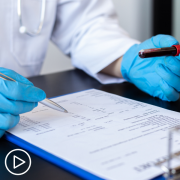
|

|
Transcript:
Katherine:
How do the results of these tests affect prognosis and treatment?
Dr. Ritchie:
Well, when a patient has AML, if they are a fit patient, if it will help us determine after initial induction, whether to cure the patient we need to do a bone marrow transplant, or we can just continue with chemotherapy.
And those are really important things to determine. So, if you have a good prognosis AML, if you have an AML that has certain translocations like inversion 16 or 821, or if you have a CEPBA mutation or you have an NPM1 mutation, and that’s all you have, you may do particularly well with chemotherapy treatment alone. And you won’t need to have a bone marrow transplant.
If you have certain other mutations, we know that the only way that we’re going to cure you, is with a bone marrow transplant. And if you are fit, when we finish induction and even as we’re doing induction, we’re preparing you for a bone marrow transplant down the line.
One disadvantage, just to mention about the molecular testing, is it doesn’t come back as quickly as some of the other testing. So that you will have already started induction chemotherapy most generally before the mutational testing comes back. Which can be anywhere – depending upon the institution, between seven and 21 days. So, it takes time for those results to be available.
Katherine:
Outside of test results, Dr. Ritchie, what other factors should be considered when choosing treatment?
Dr. Ritchie:
So, you want to choose whether a patient is most likely to benefit from intense induction chemotherapy. With strong chemotherapies where the backbone of those therapies would be an anthracycline, like daunorubicin (Cerubidine) or cytarabine (Liposomal), or daunorubicin or idarubicin (Idamycin PFS), together with cytarabine. And these are intensive chemotherapies. Versus, non-intensive chemotherapy which is able to be done as an outpatient, more frequently. And it is something that is gentler for a patient, they’re less likely to have severe toxicity. And the backbone of those regimens is using a drug called azacitidine (Vidaza) or decitabine (Inqovi), together with a second drug called venetoclax (Venclexta).
So, these are the two backbones, there may be clinical trials or there may be targetable aspects of your leukemia, which drugs would be added to either of those backbones. But those are the two backbones. And I also like to identify those patients that may not benefit from chemotherapy at all. And so, it’s very important, I think to really get to know your patient. And I spend time with my patient, particularly on the first visit, to understand not only their physical health, but their mental health. How good is their cognition, what is their mood, are they depressed, or are they happy people? And what is their circumstance? Do they have people to support them? Do they live close to family? Is a caregiver able to come, with an elderly patient for example, to visits?
Those, and whether or not they’re living alone and need tremendous support. So that’s really important to determine and helps me to choose what the best therapy might be. And also, concurrently what I can do to shore up the patient to do better with whatever therapy that I’m giving them. I.e., if you’re depressed, let’s work on that, or if your blood pressure is too high, or if you are – your diabetes is out of control at the same time that I’m seeing you, to try and fix those particular problems. In older patients I often do sort of a miniature version of the geriatric assessment. And in trials that have been so far, the most important aspects of the geriatric assessment, are really what is your cognitive function? Do have a mild dementia, or do you not have a mild dementia? Because dementia may be or mild dementia may be associated with poorer outcome.
The other is, are you able to do what we call the incidental tasks of daily life. So, you know fundamental tasks are really brushing your teeth and combing your hair, and dressing yourself. But are you able to do your cooking and your shopping and your banking and those things? Patients who have trouble doing their cooking and shopping and banking, and those types of activities, that also has been associated with a poor overall survival in AML. So, it’s really important to determine all of those aspects and if there are any deficiencies, to really know that the only therapeutic choice for that particular patient would be a low-intensity therapy.




